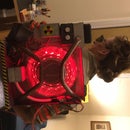Introduction: Mount a Bottle Cage on a Bike That Doesn't Have Mounting Points
My bike had no permanent mounting points for a bottle cage. A lot of bottle cages that use straps to attach to the bike frame slip as you ride, and I wanted something more sturdy. So I installed rivnuts to mount a cage to.
I didn't want to spend a ton of money on a special tool I'm only going to use once, so I'll show you the cheap way I installed the rivnuts.
If you decide to try this, I found this video to be very helpful: https://www.youtube.com/watch?v=qNLo2rIw5M8
Supplies
- bottle cage you want to mount
- rivnuts (I used m4)
- mounting hardware to mount bottle cage (I used m4 x 16)
- 1 too-long screw that fits your rivnut and one nut that is too large for that screw (this will be used for installing the rivnuts. I used m4x 30 and a nut I had lying around)
- tap magic or other coolant for drilling
- masking tape and marking pen
- drill and drill bits
- hammer and nail or center punch
- ruler or calipers
- screwdriver
- wrench or vice grips
- metal file(s)
Step 1: Figure Out Where You Want the Bottle Cage to Go
Use masking tape to mark off the general area on your bike where you want to mount your bottle cage. Make sure to leave clearance to get the bottle easily in and out of the cage without hitting anything, and make sure that other things like locks can still be easily used.
Once you are happy with where you have the cage, use a marker to trace the mounting holes onto the masking tape.
Step 2: Measure Twice, Drill Once
Use a caliper or ruler to double-check the marks on the tape against the holes in your bottle cage to make sure you've marked them well.
If you're happy with the placement, start drilling your holes, making sure to stay perpendicular to the tube of the bike as best as you can. Use a couple drops of Tap Magic or some other coolant to keep your drill bit and bike cool while you are drilling. If you see smoke, take a break and let everything cool down. You may find that the drill wants to skip around on the frame when you're starting. I found it helpful to use a hammer and nail to mark where I wanted to drill and drilled a smaller pilot hole first.
Note: the drill bit you use to make the holes for your rivnuts will depend on the size of the rivnut, which will depend on the size of the mounting hardware you are planning to use to attach your bottle cage. You'll want to google the size of hole to make for your rivnut.
Use a metal file to clean up the edges when you are done drilling, to remove any burrs and blunt sharp edges.
Step 3: Install the Rivnuts
There are special (and expensive!) tools you can use to install the rivnuts, but you can also just use a screw and a nut. The screw should be long enough to engage the full depth of the rivnut when it's in the bike, but not so long that it will hit the other side of the frame. The nut should be large enough that the screw can turn freely inside it without engaging any threads, but small enough that the head of the screw cannot pass through the nut.
I screwed the first couple threads of the rivnut onto the screw and used the screw as a handle to push the rivnut into place in my drilled hole. Make sure the rivnut is flush with the bike frame. Use a wrench or vice grips to hold the nut still and tighten the screw. You'll feel the resistance as the rivnut deforms. Keep tightening until you feel the resistance increase suddenly. Back the screw out. Your rivnut is installed! Repeat with the second rivnut.
Step 4: Install Your Bottle Cage
Use the mounting hardware you selected to install your bottle cage.












